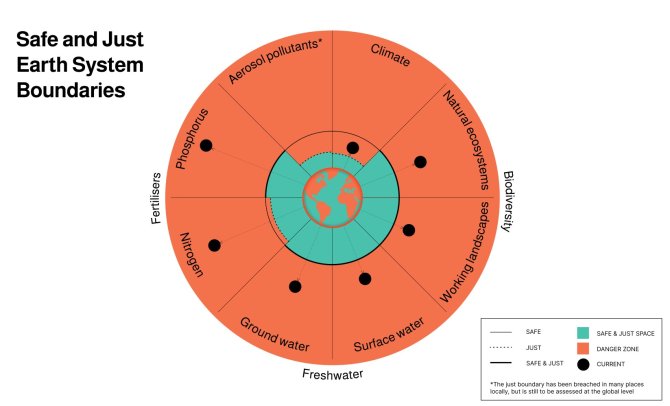
News
A just world on a safe planet: First study quantifying safe and just Earth System Boundaries
Humans are taking colossal risks with the future of civilization and everything that lives on Earth, a new study published in the journal Nature shows. Developed by an international science commission engaging more than 40 researchers from across the globe, the scientists deliver the first quantification of safe and just Earth system boundaries on a global and regional level for several biophysical processes and systems that regulate the state of the Earth system.
For the first time, safety and justice for humanity on Earth is assessed and quantified for the same control variables regulating life support and Earth stability. Justice, assessed based on avoiding significant harm to people across the world, tightens the Earth system boundaries, providing even less available space for humans on Earth. This is extremely challenging, as the Earth Commission concludes that several safe boundaries are already crossed today.
“We are in the Anthropocene, putting the stability and resilience of the entire planet at risk. This is why, for the first time, we present quantifiable numbers and a solid scientific foundation to assess the state of our planetary health not only in terms of Earth System stability and resilience but also in terms of human wellbeing and equity / justice,” says Prof. Johan Rockström, Earth Commission Co-Chair, lead author and Director of the Potsdam Institute for Climate Impact Research.
“This work adds a crucial dimension to the safe planetary boundaries we defined previously,” says co-author Prof. Marten Scheffer of Wageningen University & Research. “Things that may look safe from a global perspective, can still put huge groups of vulnerable people in danger. For instance, as we showed in a related paper last week, each 0.1 degree of global warming may displace 140 million people, all of them from the Global South”.
Safe and Just boundaries
Safe boundaries ensure stable and resilient conditions on Earth. A stable and resilient Earth is dominated by balancing feedbacks that cope with buffer and dampen disturbances. Cutting edge science on climate tipping points feature as one major line of evidence to set safe boundaries.
Just boundaries minimize human exposure to significant harm. The Commission defines significant harm as: widespread severe existential or irreversible negative impacts on countries, communities and individuals from Earth system change, such as loss of lives, livelihoods or incomes, displacement, loss of food, water or nutritional security, chronic disease, injury or malnutrition.
The Earth System boundaries take the stricter of the quantified Safe and Just Earth System Boundaries.
Health indicators for people and planet
The Earth Commission has quantified safe and just boundaries for climate, biodiversity, freshwater and different kinds of pollution to air, soil and water - and most have been breached. For example, human activities are altering water availability , excessive amounts of nutrients from fertilizer use are released into waterways, and limited natural areas are left.
“Especially for the nutrients nitrogen and phosphorus, this work adds a crucial aspect by not only presenting safe planetary boundaries, but also including the regional variation in those boundaries,” says co-author Prof. Wim de Vries of Wageningen University & Research. “There is both a shortage in the use of those nutrients in view of food production, for example in large parts of Africa, and an excess, for example in large parts of China, Europe and the USA, affecting both ecosystems and human health.”
Global target setting has especially focused on climate change and limiting global warming well below 2°C and aiming at 1.5°C according to the Paris Agreement. Science also clearly shows there is a need to manage all the other biophysical systems and processes on Earth that determine the livability on the planet. Overall, violating the various boundaries poses existential threats for a stable planet, to ecosystems and their vital contributions to people. The world has already passed the safe and just climate boundary, which is set at 1°C above pre-industrial temperature levels, as tens of millions of people are already harmed by the current level of climate change.

Justice tightens available space for humans on Earth
The new study builds on authoritative scientific evidence defining the biophysical conditions to maintain a stable planet to underpin life on Earth (“safe”) as well as assessing how significant harm can be avoided to humans and other species. Past scientific attempts to define environmental boundaries, such as the Planetary Boundary framework, have looked at the global conditions needed to maintain a stable planet and safeguard life on Earth.
“We now looked more strictly at what would be needed to prevent large numbers of people to run into trouble,” says Scheffer. “And we also looked at the regional variation of several boundaries, such as those for nutrients,” adds De Vries.
Science for real world application
The Earth Systems Boundaries will underpin the setting of new science-based targets for businesses, cities and governments to address the polycrises of: increasing human exposure to the climate emergency, biodiversity decline, water shortages, ecosystem damage from fertiliser overuse in some parts of the world coupled with lack of access elsewhere which limits food production, and health damage from air pollution. In a time of increasing scrutiny and expectations, the resilience and success of businesses, cities and governments will depend on their ability to accurately measure and improve their impact on people and planet - and target opportunities within the finite limits of the planet.